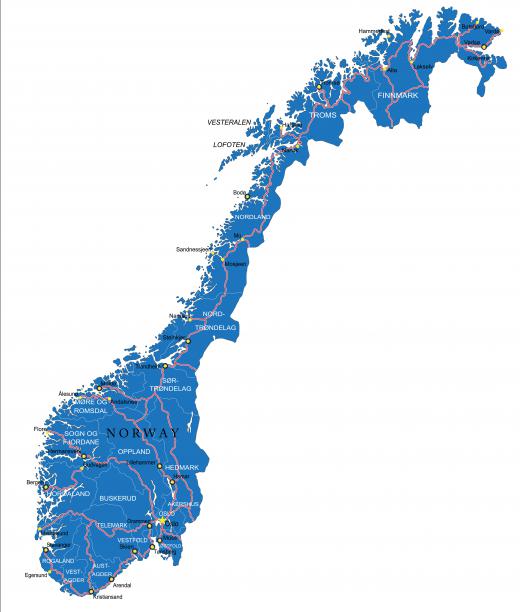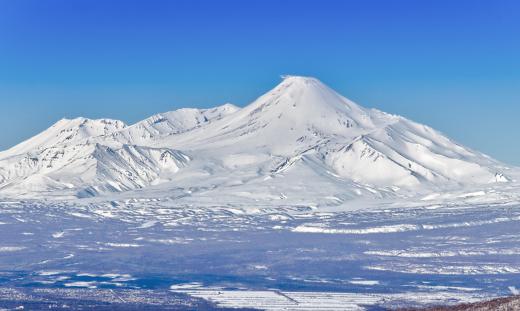What is an Ice Sheet?
 Michael Anissimov
Michael Anissimov
An ice sheet is a large permanent layer of ice covering a continental shelf, defined as having an extent greater than 50,000 km2 (19,305 mi2). An ice sheet is larger than a glacier or ice shelf. There are two ice sheets in the world today: the Antarctic ice sheet (which contains 61% of fresh water on the planet) and the Greenland ice sheet (containing 7%). Only about 32% of the world's fresh water is found in streams, lakes, and aquifers — the rest can be found in the ice sheets.
Ice sheets form when snow falls on ground with a subzero temperature and doesn't melt, even seasonally. Over thousands of years, the snow builds up and compacts into ice, forming sheets averaging 1 mi (1.6 km) thick, or up to 2 mi (3.2 km) at maximum. In some areas of the West Antarctic ice sheet, the base is as far as 1.5 mi (2.4 km) below sea level, comparable to the depth of some areas of ocean. If the entire Antarctic ice sheet or the Greenland ice sheet were to melt, the world's seas would rise by about 60 meters or 7 meters, respectively. The possibility of the ice sheets melting due to global warming has been a cause of concern worldwide in recent decades.

Land covered by ice sheets takes on a characteristic jagged appearance due to extensive glacial weathering. Terrain of this type can be seen in Patagonia (far southern South America), Norway, northern Canada, and Siberia. All of these areas were covered by ice sheets during the last Ice Age, more than 10,000 years ago. Only when the ice sheets receded could mankind colonize these areas.

Ice sheets are an environment largely sterile of life. Despite being made of nothing but frozen water, ice sheets tend to be very dry, providing little moisture for life to thrive on. They cover the earth, preventing the buildup of nutrient-rich soil. The only life forms that really make their home on the ice sheets are microbes that live on rocks peeking out from the ice, blown there by the wind. The tips of hills or mountains sticking out of ice sheets are called nunataks.

The Earth did not always have ice sheets around the poles. In fact, such a circumstance is relatively atypical. For most of the Earth's history, the climate was warm enough that ice sheets did not form around the poles, and forests stretched from pole to pole. Dinosaur fossils have even been found less than 10 degrees latitude away from the South Pole.
AS FEATURED ON:
AS FEATURED ON:














Discussion Comments
@ Alchemy- There is much more at work than just the Milankovitch cycles when it comes to climate change. While humans do not affect the Milankovitch cycles, people affect albedo (reflection of solar radiation into space by ice sheets and glaciers) and atmospheric greenhouse gas concentration. By increasing the greenhouse gases in the atmosphere through the burning of fossil fuels, we are creating a barrier for heat radiating from the earth to return to space. This in turn causes higher surface and ocean temperatures, which increase the melting of polar ice caps. This leads to higher melting and more ice caps, in turn leading to more melting. You now have caused a mutation in the climate cycle; changing it from a negative feedback cycle to a positive feedback cycle. This has also happened in such a short period in the planets history that could mean unprecedented changes in an already capricious climate. My point is that nature is not benign; rather it has limits, and may even be somewhat fragile in certain respects.
@ Comparables- So if the earth's climate is controlled by these natural space cycles then what is the whole fuss about saving the arctic ice sheets and global warming. We should want to warm the earth if we are headed toward a period of glaciers and ice ages. I was always skeptical of global warming and never really thought it stood up to the tests of real science. I don't get why people think we have such an effect on the planet.
The statement that ice sheets around the poles is actually false. The earth has been going through cycles of ice ages and great thaws for most of its history. These circumstances are controlled by the regular shifts in the orbit of the earth called the Milankovitch cycles. The earth’s orbit moves from more elliptical to more circular in cycles that run approximately 410,000 years. Furthermore, the axial tilt of the earth shifts by almost two degrees and back every 41,000 years. This was a hypothesis, until 1975 when deep ocean ice cores were able to prove Milankovitch's theory by analyzing oxygen isotopes locked up in prehistoric fossils in the ocean sediment.
Essentially what all of this means is that the earth goes through periods of glaciation because of the change in distance from the sun and the obliquity of the earth in relation to the sun. These variations cause normal periods where polar ice sheets nearly reach the tropics to nearly no ice caps at all every 130,000 to 650,000 years. If you were to ignore the anthropogenic effects on climate, the Earth would be at the point where it begins to move toward a glacial period.
Post your comments